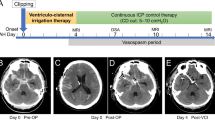Abstract
Background
External ventricular drain (EVD) placement temporarily provides cerebrospinal fluid (CSF) diversion and is indicated in patients with aneurysmal subarachnoid hemorrhage (aSAH) to relieve hydrocephalus.
Methods
Case report.
Results
A 56-year-old woman was admitted to our hospital with aSAH complicated by acute hydrocephalus. An EVD was placed and set to 15 mmHg. After nearly 72 h, she clinically deteriorated. A computed tomography (CT) perfusion scan showed hypoperfusion in the watershed regions in both hemispheres and CT angiogram showed mild segmental arterial narrowings. After the EVD was lowered to 5 mmHg, the radiologic perfusion abnormalities and clinical symptoms resolved.
Conclusions
We postulate a mechanism by which CSF diversion could decrease the risk of delayed cerebral ischemia after aSAH: CSF drainage at low levels of intracranial pressure (e.g., 5 mmHg) could improve blood flow in the microcirculation, and thus improve tissue perfusion.



Similar content being viewed by others
References
Kassell NF, Torner JC, Haley EC Jr, Jane JA, Adams HP, Kongable GL. The international cooperative study on the timing of aneurysm surgery. Part 1: overall management results. J Neurosurg. 1990;73:18–36.
Fergusen S, Macdonald RL. Predictors of cerebral infarction in patients with aneurysmal subarachnoid hemorrhage. Neurosurgery. 2007;60:658–67.
Hutter BO, Kreitschmann-Andermahr I, Gilsbach JM. Cognitive deficits in the acute stage after subarachnoid hemorrhage. Neurosurgery. 1998;43:1054–65.
van Gijn J, Hijdra A, Wijdicks EF, Vermeulen M, van Crevel H. Acute hydrocephalus after aneurysmal subarachnoid hemorrhage. J Neurosurg. 1985;63:355–632.
Samuelsson C, Howells T, Kumlien E, Enblad P, Hillered L, Ronne-Engstrom E. Relationship between intracranial hemodynamics and microdialysis markers of energy metabolism and glutamate-glutamine turnover in patients with subarachnoid hemorrhage. Clinical article. J Neurosurg. 2009;111:910–5.
Ryttlefors M, Howells T, Nilsson P, Ronne-Engstrom E, Enblad P. Secondary insults in subarachnoid hemorrhage: occurrence and impact on outcome and clinical deterioration. Neurosurgery. 2007;61:704–14 (discussion 14–15).
Menon D, Weir B, Overton T. Ventricular size and cerebral blood flow following subarachnoid hemorrhage. J Comput Assist Tomogr. 1981;5:328–33.
Hayashi M, Kobayashi H, Kawano H, Yamamoto S, Maeda T. Cerebral blood flow and ICP patterns in patients with communicating hydrocephalus after aneurysm rupture. J Neurosurg. 1984;61:30–6.
Hasan D, van Peski J, Loeve I, Krenning EP, Vermeulen M. Single photon emission computed tomography in patients with acute hydrocephalus or with cerebral ischaemia after subarachnoid haemorrhage. J Neurol Neurosurg Psychiatry. 1991;54:490–3.
van Asch CJ, van der Schaaf IC, Rinkel GJ. Acute hydrocephalus and cerebral perfusion after aneurysmal subarachnoid hemorrhage. AJNR Am J Neuroradiol. 2010;31:67–70.
Nornes H. The role of intracranial pressure in the arrest of hemorrhage in patients with ruptured intracranial aneurysm. J Neurosurg. 1973;39:226–34.
Voldby B, Enevoldsen EM. Intracranial pressure changes following aneurysm rupture. Part 3: recurrent hemorrhage. J Neurosurg. 1982;56:784–9.
McIver JI, Friedman JA, Wijdicks EF, et al. Preoperative ventriculostomy and rebleeding after aneurysmal subarachnoid hemorrhage. J Neurosurg. 2002;97:1042–4.
Rajshekhar V, Harbaugh RE. Results of routine ventriculostomy with external ventricular drainage for acute hydrocephalus following subarachnoid haemorrhage. Acta Neurochir (Wien). 1992;115:8–14.
Roitberg BZ, Khan N, Alp MS, Hersonskey T, Charbel FT, Ausman JI. Bedside external ventricular drain placement for the treatment of acute hydrocephalus. Br J Neurosurg. 2001;15:324–7.
Hellingman CA, van den Bergh WM, Beijer IS, et al. Risk of rebleeding after treatment of acute hydrocephalus in patients with aneurysmal subarachnoid hemorrhage. Stroke. J Cereb Circ. 2007;38:96–9.
Kasuya H, Shimizu T, Kagawa M. The effect of continuous drainage of cerebrospinal fluid in patients with subarachnoid hemorrhage: a retrospective analysis of 108 patients. Neurosurgery. 1991;28:56–9.
Hartmann A, Alberti E, Lange D. Effects of CSF-drainage on CBF and CBV in subarachnoid hemorrhage and communicating hydrocephalus. Acta Neurol Scand Suppl. 1977;64:336–7.
Fisher CM, Kistler JP, Davis JM. Relation of cerebral vasospasm to subarachnoid hemorrhage visualized by computerized tomographic scanning. Neurosurgery. 1980;6:1–9.
Sakaki S, Ohta S, Kuwabara H, Shiraishi M. The role of ventricular and cisternal drainage in the early operation for ruptured intracranial aneurysms. Acta Neurochir (Wien). 1987;88:87–94.
Sonobe M, Takahashi S, Otsuki T, Kubota Y. Preventive effect on intracranial arterial vasospasm using combined ventriculo-cisternal and cisternal drainage (author’s transl)]. No Shinkei Geka. 1981;9:1393–7.
Kim GS, Amato A, James ML, et al. Continuous and intermittent CSF diversion after subarachnoid hemorrhage: a pilot study. Neurocrit Care. 2011;14:68–72.
Disclosures
Drs. Fugate, Rabinstein, and Wijdicks have no disclosures. Dr. Lanzino has educational grants from Covidien and Synthes.
Author information
Authors and Affiliations
Corresponding author
Rights and permissions
About this article
Cite this article
Fugate, J.E., Rabinstein, A.A., Wijdicks, E.F.M. et al. Aggressive CSF Diversion Reverses Delayed Cerebral Ischemia in Aneurysmal Subarachnoid Hemorrhage: A Case Report. Neurocrit Care 17, 112–116 (2012). https://doi.org/10.1007/s12028-012-9723-z
Published:
Issue Date:
DOI: https://doi.org/10.1007/s12028-012-9723-z




